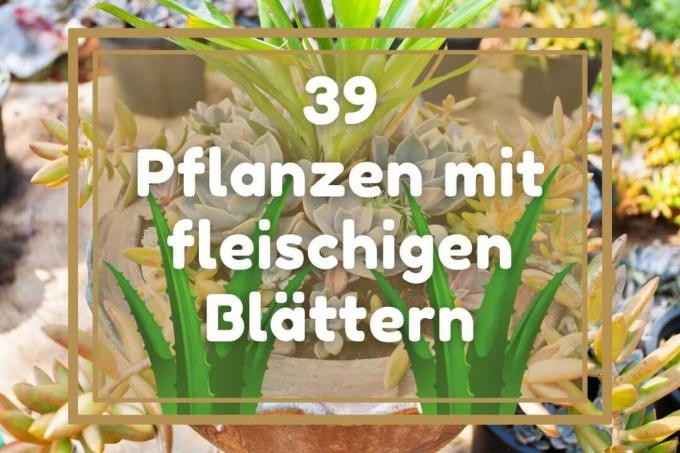
table of contents
- Plants with fleshy leaves for the garden
- Agaves (agave)
- Donarsbart (Jovibarba heuffelii)
- Fettblatt (Sedum)
- Houseleek (Sempervivum)
- Palm lilies (yucca)
- Plants with fleshy leaves for indoor culture
- Aloes (aloe)
- Echeveria (Echeveria)
- Lizard skin thick leaf (Crassula tecta)
- Flaming Käthchen (Kalanchoë blossfeldiana)
- Money tree (Crassula ovata)
- Penny Tree (Crassula arborescens)
- frequently asked Questions
Thick, fleshy leaves are the characteristic feature of the thick-leaf family (Crassulaceae), which, like the cacti, belong to the succulents. We present 39 particularly beautiful species for garden and indoor culture.
In a nutshell
- large, succulent plant family with several thousand species
- thickened, fleshy leaves store water
- undemanding and very easy to care for
- many hardy species for the garden
- however, fleshy leaves are also found in other succulent plant families
Plants with fleshy leaves for the garden
These plants are able to store enough water in their fleshy leaves to survive in dry places.
Agaves (agave)
- also known as the century plant
- rosette-like growth with a short trunk or without trunk
- Depending on the type, small to very large rosettes
- fibrous, thick, fleshy leaves
- thorny blade tip (risk of injury)
Popular agave species for pots and garden beds
- Agave parryi: spherical growth with a diameter of up to 80 centimeters, leaves up to 30 centimeters long, tolerates short periods of frost up to approx. minus 20 ° C
- Agave utahensis ("Utah agave"): up to 40 centimeters in diameter, yellow-green to bluish leaves up to 30 centimeters long with a pointed end thorn, tolerates up to approx. minus 20 ° C
- Agave inaequidens: forms a short trunk, light to yellow-green, up to 150 centimeters long leaves with toothed edges
- Agave havardiana: open rosettes up to 80 centimeters in diameter, up to 60 centimeters long, strongly toothed leaves, hardy up to approx. minus 18 ° C
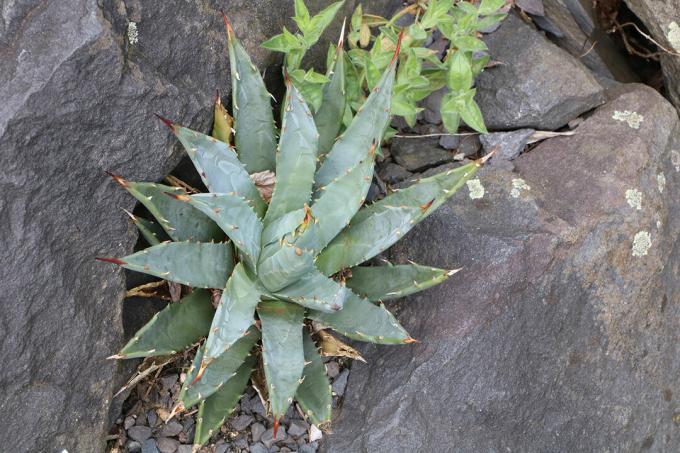
Note: The problem with the Overwintering of agaves it is not so much the cold as the moisture anyway: agaves cannot stand our wet winters and perish from excess water. A dry culture is better guaranteed in a bucket.
Donarsbart (Jovibarba heuffelii)
- also known as fringed house root
- up to 12 inches high
- rosette growth
- forms cushions
- yellow clusters of flowers between June and August
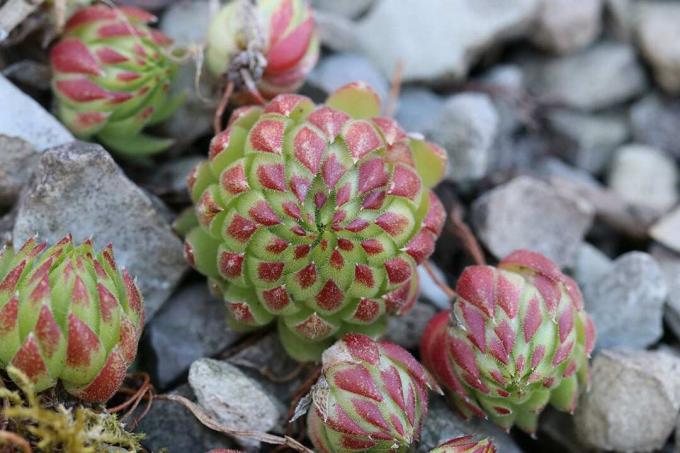
Note: It is best to plant the Donarsbart in small tuffs with three to ten pieces with a plant spacing 15 to 20 centimeters in a sunny, dry place - for example in a rock garden or in wall joints.
Fettblatt (Sedum)
- also known as stonecrop
- about 600 different species
- undemanding, robust, hardy and easy to care for
- for the garden as well as for the apartment
- for sunny locations
Popular types of fat leaf
- Large fat sheet (Sedum telephium): up to 60 centimeters high, bushy habit, pink umbellate flowers between August and October
- Evergreen fat leaf (Sedum hybridum): up to 15 centimeters high, forming a carpet, small, yellow flowers between June and August
- Magnificent fat sheet (Sedum spectabile): up to 40 centimeters high, bushy habit, large umbellate flowers in different colors, flowering period August to September
- Hot stonecrop (Sedum acre): native species for maple soils, up to 10 centimeters high, carpet-forming, yellow flowers between June and July
- Carpet fat sheet (Sedum spurium): up to 15 centimeters high, forms dense carpets, small flowers between June and August
- White stonecrop (Sedum album): for barren soils, up to 10 centimeters high, carpet-forming, white or pink flowers between June and August
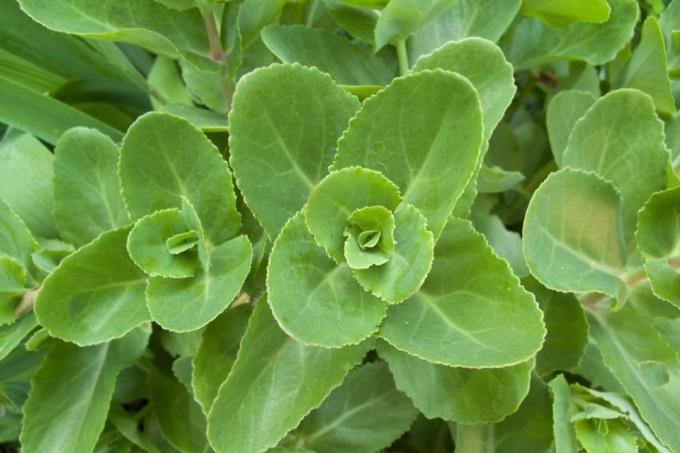
Houseleek (Sempervivum)
- native thick leaf plant
- also known as roof root or stone rose
- very robust, undemanding and hardy
- about 40 different species and over 7000 varieties
Popular houseleek species
- Real houseleek (Sempervivum tectorum): 5 to 30 centimeters high, rosette-like growth, forming a carpet
- Mountain houseleek (Sempervivum montanum): evergreen, up to 20 centimeters high, up to 10 centimeters long runners, large, red flowers between July and September
- Dolomite houseleek (Sempervivum dolomiticum): up to 15 centimeters high, rosettes up to five centimeters wide, pink-red to purple colored flowers
- Large-flowered houseleek (Sempervivum grandiflorum): large, up to 10 centimeters wide leaf rosettes, up to 30 centimeters high flowering shoots, yellow, large flowers
- Cobweb houseleek (Sempervivum arachnoideum): evergreen, up to 10 centimeters high, leaf rosettes with cobweb-like spinning, small, pink flowers between June and July
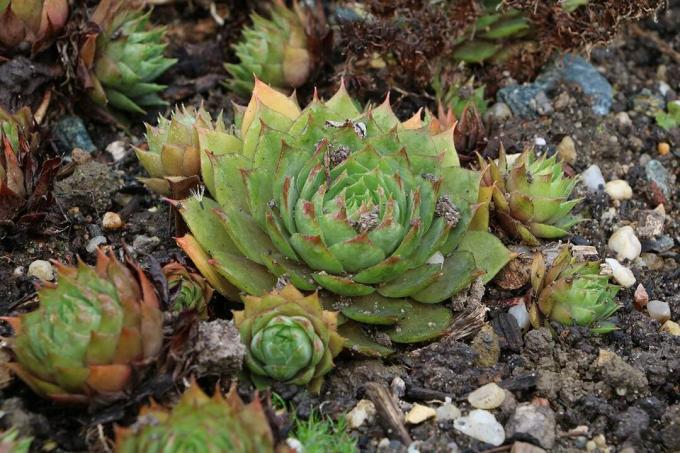
Note: The native roof root is extremely robust against frosty temperatures, but does not tolerate any moisture. Therefore, these plants should be placed in places protected from moisture.
Palm lilies (yucca)
- perennial plants from the asparagus family (Asparagaceae)
- Long, narrow leaves arranged in rosettes
- Lily of the valley-like inflorescences
- native to Central America, especially Mexico
- around 50 different species, some of them frost hardy
Hardy palm lilies for the garden
- Blue palm lily (Yucca baccata): stemless or with a short stem, leaves up to 70 centimeters long, short inflorescences between April and July, frost hardy to minus 20 ° C
- Threaded palm lily (Yucca filamentosa): up to 120 centimeters high, imposing inflorescences with large, white flowers, very hardy and robust
- Candle palm lily (Yucca gloriosa): native to North America, develops a trunk up to two meters high with age, flowering time in autumn, conditionally hardy
- Dwarf palm lily (Yucca nana): forms rosettes with a diameter of up to 25 centimeters, up to a meter high inflorescence in May, frost hardy to minus 20 ° C
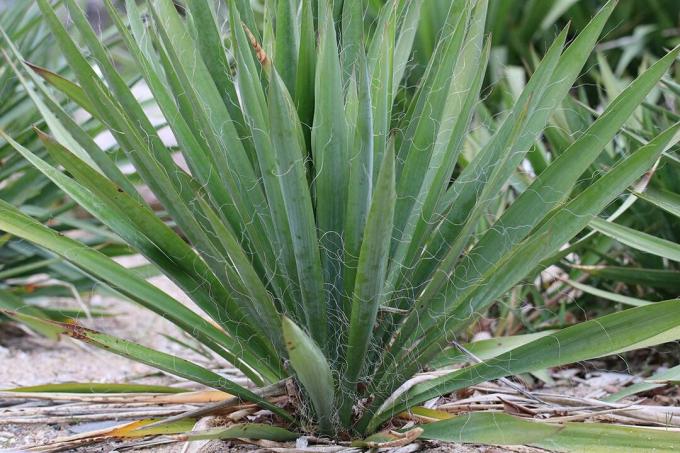
Note: Palm lilies also include those that are not frost-hardy and are therefore kept exclusively in room culture Yucca palm, which is botanically correct called Yucca elephantipes (giant palm lily) and is between two and ten meters high can be.
Plants with fleshy leaves for indoor culture
Some plants delight not only with their fleshy leaves, but also with their flowers. These are often kept as indoor plants.
Aloes (aloe)
- Plants from the subfamily of the Affodilla family (Asphodeloideae)
- over 500 different types
- different growth forms: trunkless, shrub-like or tree-shaped
- Leaves are often long, triangular and toothed or studded with spines
- native mainly to south and east Africa
Popular types of aloe for indoor culture
- Real aloe (Aloe vera): up to 50 centimeters long, gray-green, toothed leaves, rosette-like growth without resp. with a short trunk, well-known medicinal plant
- Eternal aloe or Tree aloe (Aloe arborescens): forms a trunk, branches out strongly, up to three meters high, noticeably toothed leaves
- Fan aloe (Aloe aculeata): forms several stems and a branched crown, spreading, fan-like growth, very narrow leaves without teeth
- Globular aloe (Aloe aristata): grows in groups of several rosettes, dwarf form with leaves up to 15 centimeters long with white spots, poisonous
- Spiral aloe (Aloe polyphylla): distinctive rosette with spirally arranged fleshy leaves, often with a colored tip, poisonous
- Prickly aloe (Aloe aculeata): up to 60 centimeters long, fleshy leaves in a large leaf rosette, conspicuous red teeth on leaf edges and leaf surfaces
- Tiger aloe (Aloe variegata): dwarf aloe with piebald leaves, only up to approx. 15 centimeters high
- Wild aloe or Cape aloe (Aloe ferox): from South Africa, stem-forming, pale green to reddish leaves up to 100 centimeters long
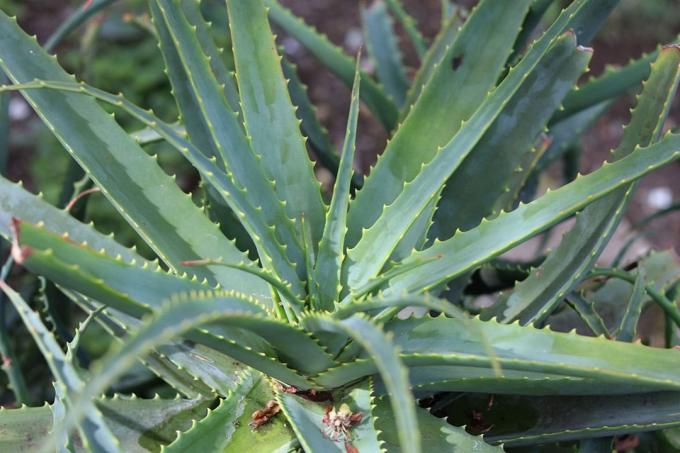
Note: Aloe vera, which is used as a medicinal plant, is probably particularly well-known and popular. But be careful: This is often confused with other, but poisonous species. Therefore, pay attention to the correct plant name when buying.
Echeveria (Echeveria)
- perennial, evergreen, succulent thick leaf plants
- especially large, fleshy leaves
- large rosettes, mostly without stem
- Native to Central and South America, many species from Mexico
- about 150 different species
Popular echeveria for room culture
- Echeveria agavoides: up to 15 centimeters high, leaf rosettes up to 35 centimeters in diameter, single leaves up to seven centimeters long
- Echeveria elegans: Rosettes up to 10 centimeters in diameter, light green, fleshy leaves with transparent edges
- Echeveria habenbergii: forms spherical rosettes up to 17 centimeters wide on a stem, blue-green leaves, flowers orange-red in late summer
- Echeveria leucotricha: Subshrub with light green, very thick leaves and red flowers
- Echeveria gibbiflora: Subshrub with gray-green leaves and light red flowers, rare
- Echeveria harmsii: forms loose rosettes with strong green leaves, scarlet or yellow, solitary flowers
- Echeveria pulvinata: forms loose rosettes with white hairy leaves, balding from below over time (stem formation), scarlet flowers
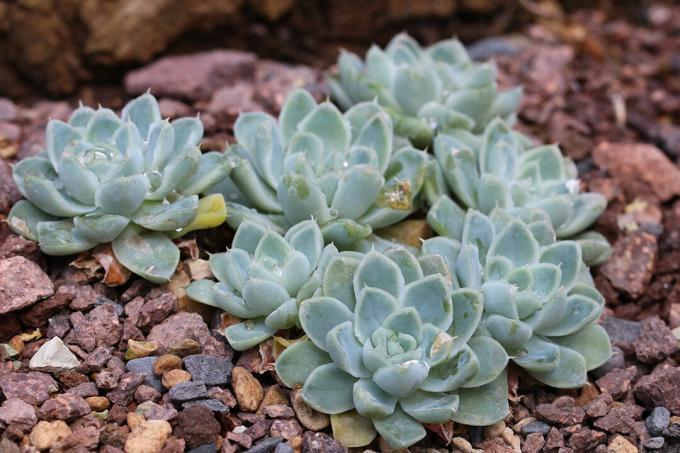
Lizard skin thick leaf (Crassula tecta)
- native to South Africa
- Leaves covered with white, small papillae (knobs)
- dwarf growing rosette plant
- Leaves up to 25 millimeters long
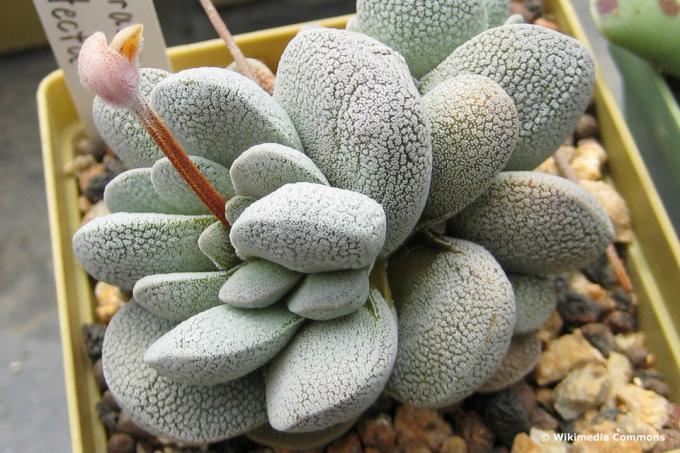
Tip: This distinctive thick leaf plant needs a mineral substrate and should only be watered sparingly. Fertilization is only necessary once a year.
Flaming Käthchen (Kalanchoë blossfeldiana)
- up to 40 centimeters high
- persistent, abundant flowering in the winter months
- many flower colors: red, pink, purple, orange, yellow, white
- easy to care for, for sunny window sills
- perennial, can be made to bloom again and again
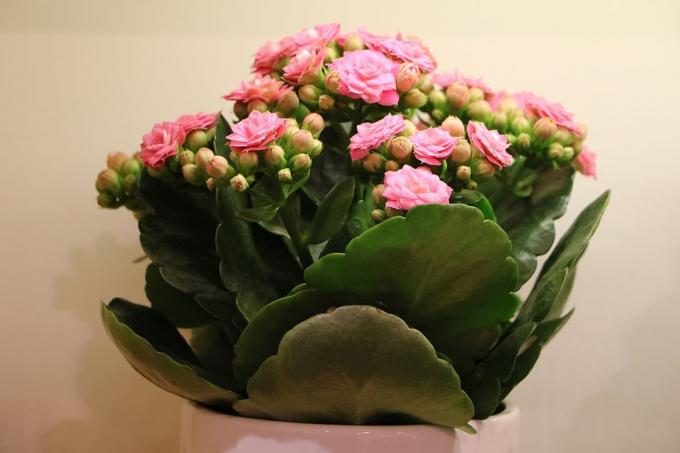
Note: The popular houseplant is often thrown away after flowering, but you can use a trick to get it to flower again and again. To do this, darken the plants in autumn for several weeks every day for 12 to 14 hours, e.g. B. by putting a cardboard over it.
Money tree (Crassula ovata)
- grows up to 100 centimeters high
- bushy to tree-like growth
- easy to care for and very frugal
- for sunny to partially shaded locations
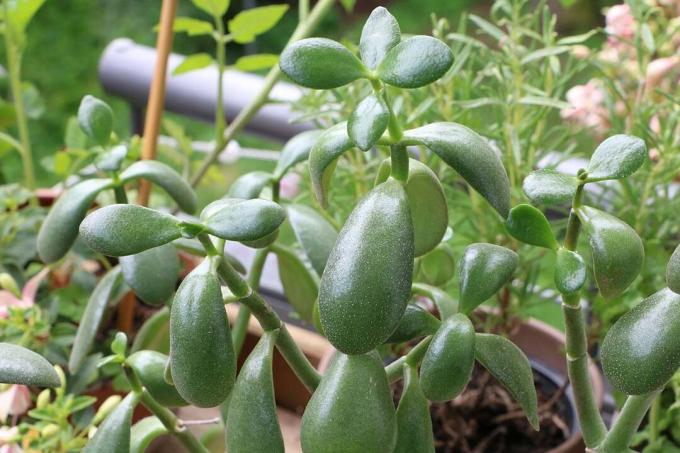
Note: It is little known, but specimens of the money tree that have grown in summer can bloom between February and April. The small panicles of flowers are pink or white and have a light scent.
Penny Tree (Crassula arborescens)
- tree-like, strongly branched growth
- up to 150 centimeters in height, trunk thickness up to six centimeters
- thickened, gray-green leaves with reddish margins and a powdery coating
- native to South Africa
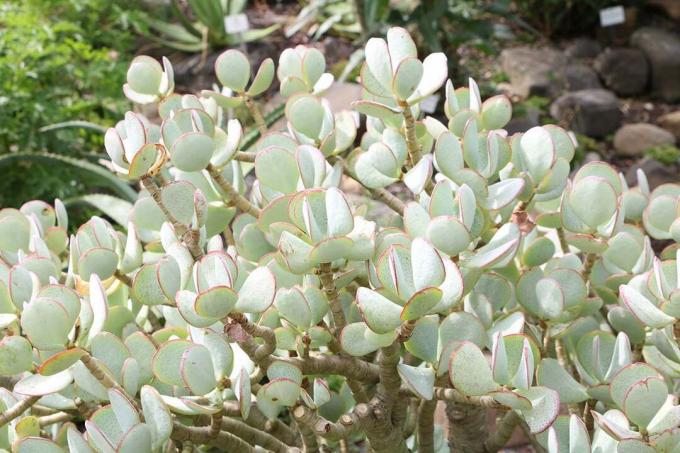
frequently asked Questions
The thick-fleshed leaves are a characteristic feature of the thick-leaf family. The plants that live in dry regions of the world store water in them, which is why they, like cacti, are counted among the succulents. Incidentally, the thick-leaf family (Crassulaceae) is a family of plants that includes several thousand species and occurs all over the world with the exception of Antarctica. But not all plants with fleshy leaves belong to the thick-leaf family - other succulents also have this characteristic, such as aloes or agaves.
This family of succulents is not only characterized by an immense variety of shapes and colors, but also by their undemanding and easy-care properties. These make the thick-leaf plants popular ornamental plants for garden beds and for planters. They only need a little water, rarely (or not at all) need fertilization and mostly prefer a mineral substrate. Above all, make sure that you use water sparingly and that you never keep the plants too moist or even waterlogged.
Thick-leaf plants occur - with the exception of the Antarctic - in almost all regions of the world, provided that it is dry there. Because of the ability to store water in their fleshy leaves, survivors cope with arid conditions that ravage other plant species. Depending on their origin, many species are even hardy and can therefore be planted in the garden. Others, however, can only tolerate frost for a short time. should mainly be protected from moisture in winter.
